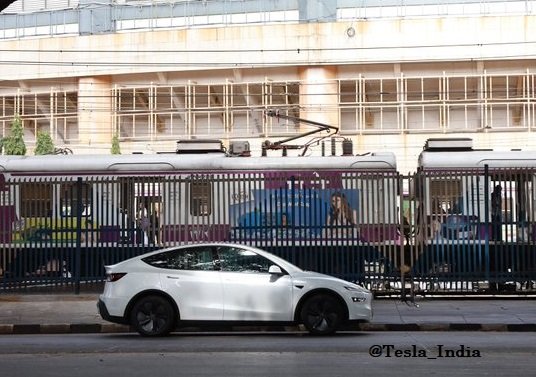Last Updated on July 17, 2025 12:08 pm by BIZNAMA NEWS
R. Suryamurthy
The Indian electric vehicle (EV) market is on the cusp of an explosion, with global titans and domestic champions vying for dominance in a landscape rapidly shifting towards sustainable mobility. While Tesla’s long-awaited official entry has generated significant buzz, its premium pricing strategy sets the stage for an intense battle against established players like BYD India, and homegrown stalwarts such as Tata Motors and Mahindra.
Tesla, the undisputed global EV pioneer, has finally inaugurated its first showroom in Mumbai’s upscale Bandra Kurla Complex, with a second set to open in New Delhi later this month.
However, the sticker shock for Indian consumers is undeniable. The Tesla Model Y, which serves as the brand’s flagship offering in India, starts at ₹59.89 lakh (ex-showroom) for the entry-level Rear-Wheel Drive variant, soaring to ₹67.89 lakh for the Long Range version. This stands in stark contrast to its pricing in other major markets: approximately $44,990 (₹37.5 lakh) in the U.S., 263,500 yuan (₹29.9 lakh) in China, and €45,970 (₹45.6 lakh) in Germany.
The significant price disparity is primarily attributed to India’s steep import duties, which can reach up to 110% for Completely Built Units (CBUs) priced over $40,000. Even with the recently updated Scheme for Manufacturing of Electric Cars (SMEC), offering a reduced 15% import duty for EVs priced above $35,000 contingent on local manufacturing investment, Tesla’s initial approach of importing vehicles means consumers bear the brunt of these tariffs.
“This is not meaningful from a volume standpoint yet,” remarked Jay Kale, an analyst at Elara Securities. “But it plants the brand. Over time, as charging infrastructure improves and the lineup expands, Tesla could scale.”
BYD’s Aggressive Counter-Punch: Expanding Network and Local Presence
Amidst Tesla’s cautious, premium-focused debut, Chinese EV giant BYD India is not just holding its ground but aggressively expanding its footprint. The inauguration of its 42nd showroom in Sonipat, Haryana, in partnership with SAMTA BYD (Samta Greentech LLP), underscores BYD’s commitment to deepening its presence across North India and tapping into the burgeoning demand for New Energy Vehicles (NEVs). This marks the second collaboration between BYD and SAMTA BYD in Haryana, following a successful venture in Karnal.
The 2,000 sq. ft. Sonipat showroom will showcase BYD’s diverse all-electric vehicle range, including the recently launched BYD SEALION 7, alongside the popular BYD SEAL, BYD ATTO 3, and the BYD eMAX 7. This broad portfolio, coupled with an extensive dealership network, positions BYD to cater to a wider customer base than Tesla’s initial luxury niche.
Rajeev Chauhan, Head of Electric Passenger Vehicles Business at BYD India, emphasized the strategic importance of the new showroom. “The launch of our 42nd showroom in India reflects BYD’s continued commitment to expanding clean mobility across key regions,” he stated. BYD India, established in 2007, already operates two factories in India with an investment exceeding $200 million, contributing to a robust localization strategy. The global No. 1 NEV manufacturer, having sold over 4.27 million NEVs worldwide in 2024, is clearly signaling its intent to be a frontrunner in India’s accelerating electric revolution.
A Multi-Front Battle: Domestic Giants and Emerging Rivals
Tesla enters a highly competitive and complex Indian EV landscape.
Domestic Dominance: India’s EV market is heavily influenced by local players. Tata Motors has historically commanded the passenger EV segment, though its market share has seen some reduction. Mahindra & Mahindra also holds a significant position, particularly with more affordable models. These domestic companies benefit from established dealership networks, localized supply chains, and models specifically tailored to Indian conditions and price sensitivities. Models like the Tata Harrier.ev, and Mahindra’s BE 6 and XEV 9e offer competitive specifications at significantly lower price points (e.g., Harrier.ev starting at ₹21.49 lakh).
Chinese Constraints and “White Space” for Tesla: While Chinese automakers like BYD are globally formidable, they face geopolitical and regulatory hurdles in India, with some manufacturing plans being thwarted due to security concerns. This effectively creates a “clear white space” for Tesla in the premium segment, as noted by Puneet Gupta from S&P Global Mobility, where it primarily competes with luxury brands like Mercedes-Benz, BMW, and Audi, along with BYD Seal and Volvo EX40.
Vietnamese Vanguard: Vietnam’s VinFast presents a compelling emerging challenge, with a significant investment planned for a manufacturing and battery plant in Tamil Nadu. Expected to begin production by mid-2026, VinFast’s focus on local production could give it a pricing advantage over Tesla’s initial imported vehicles.
The Localization Imperative: A Long-Term Vision for Tesla
Auto experts largely agree that Tesla’s immediate market impact will be confined to a niche, affluent segment. The Model Y’s estimated price range, even with reduced duties, remains prohibitive for a mass market where the average new car transaction price is considerably lower.
Tesla’s ability to achieve significant scale in India, beyond being a “status symbol,” will depend entirely on its commitment to local manufacturing. While the Indian government’s SMEC policy offers incentives for such investments, Tesla’s current global overcapacity may temper its immediate urgency to build new large-scale production facilities in India.
The road ahead for Tesla in India is a pragmatic, incremental expansion. Its initial success will hinge on attracting a limited, affluent consumer base. The true transformative impact, and Tesla’s ability to compete on a broader scale, will only materialize if and when it commits to substantial local production, thereby addressing the critical factors of affordability, infrastructure, and intense competition in India’s dynamic and price-sensitive automotive market. The coming years will undoubtedly witness an exhilarating battle for the soul of India’s accelerating electric revolution.

